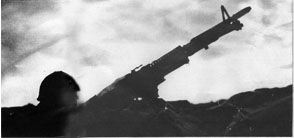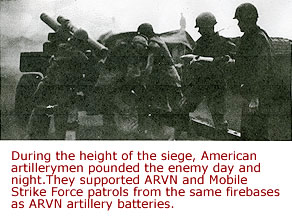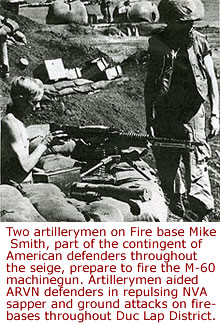It was forecast. The allied commanders knew that Quang Duc Province would be the enemy's next major target. They suspected that the NVA soldiers planned to attack and hopefully control Duc Lap by early winter and then march on to Ban Me Thuot in Darlac Province. The allies still remembered last year's engagement with the enemy at Duc Lap. They recalled the intensity with which the NVA launched attacks against Ben Het and Dak To last spring. One American advisor with the 45th ARVN suggested, "It doesn't take a crystal ball to realize why Charlie wants this place now. They need it. They need something that looks like a victory. But we're ready for them. They'll never get that victory here."
His premonition proved to be correct. The enemy, the 66th NVA Regiment that engineered the offensive against Ben het and Dak To in May and June, did attack Duc Lap. They tried to overrun the Bu Prang CIDG Camp almost to the day predicted. They attempted to disrupt resupply channels and destroy communications. They engaged ARVN and Mobile Strike Force soldiers along the Central Highland frontier stretching 30 miles southwest of Ban Me Thout into northern III Corps. They rocketed and mortared every allied camp and firebase along Quang Duc's border with Cambodia. The Allies, inevitably, suffered casualties. "We actually want them to try to get us off this hill," another high-ranking ARVN advisor pointed out before the attack. "We're dug in and ready."
After more than a month of bloody, vicious combat centering around the Bu Prang and Duc Lap CIDG-Special Forces camps, the enemy realized the allies were in fact prepared. The NVA infantry and artillery units that began their attack in late October retreated once again to their Cambodian sanctuaries after the first half of December. They withdrew, leaving behind more than 1500 of their dead comrades. More significantly, however, they departed in defeat. The ARVN's, backed by allied air and artillery support, stood their ground tenaciously once they acquired the confidence and determination to "go it alone."
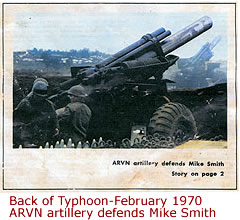 The I Field Force Forward Movile Staff spearheaded the advisory effort throughout the month-long action. Analysis of the main-force enemy drive at Ben Het six months earlier indicated that a rapid communications and advisory rapport between the ARVN and I Field Force would be essential during the action around Bu Prang. The communication and advisory liinkup would insure effctive manipulation of forces required in massive defensive or offensive retaliation. Subsequently, I Field Force prepared to deploy representatives of each of its staff sections, in addition to various other personnel required to help counter a large-scale enemy buildup. The I Field Force Forward Movile Staff spearheaded the advisory effort throughout the month-long action. Analysis of the main-force enemy drive at Ben Het six months earlier indicated that a rapid communications and advisory rapport between the ARVN and I Field Force would be essential during the action around Bu Prang. The communication and advisory liinkup would insure effctive manipulation of forces required in massive defensive or offensive retaliation. Subsequently, I Field Force prepared to deploy representatives of each of its staff sections, in addition to various other personnel required to help counter a large-scale enemy buildup.
The Forward Mobile Staff (FMS) traveled by convoy from Nha Trang to Ban Me Thout along Highway 21 after the enemy offensive was imminent. Once established and functioning, the FMS displayed its potential to relay communications swiftly and effectively to higher headquarters in Nha Trang. The MACV advisory team, headed by Colonel William Zook, senior advisor to the 23rd ARVN Division, had been prepared for the enemy offensive for weeks.
It began late in October. Enemy activity had been reported in Quang Duc Province for months, but it wasn't until October 29th that the NVA launched their drive to over-run Bu Prang and Duc Lap.
In preparation for the attack, a string of firebaseshad been hacked out of the jungle. These were designed to support the ARVN and CIDG patrols that had been combing the hills and forests for weeks. "These firebases were never designed to be permanent locaations," explained Colonel Francis Bowers, commander of the Provisional Artillery Group, headquaarters for all American artillery batteries in southern II Corps. Artillerymen began digging in on firebases called Susan, Annie, Helen, and Kate. Charlie Battery, 1st Battalion, 92nd Artillery was pt on Kate. (See story insert.)
On the night of October 29th, the NVA artillery battalion began blasting the isolated border firebases with 81mm mortar rounds, 75mm recoiless rifle fire fire and both 107 and 122mm rockets. These shellings impeded the allied artillery batteries from retaliating in full. Only during the infrequent lulls was it safe for them to leave their bunkers and fire back at the enemy. For more than 40 hours, the enemy continued in bombardment of Firebases Kate, Susan, Helen, and Annie. Finally th eorder to evacuate these firebases was relayed to the artillerymen on Kate. On the night of October 31st, after an apparent lull in the shelling, Charlie Battery began their withdrawal from the besieged hill. They marched through the night and into the next morning, completing a wide arc around the enemy positions that had all but surrounded the outpost. The next afternoon the artillerymen arrived safely at the Bu Prang CIDG-Special Forces Camp.
Immediately after Kate's evacuation, the entire hilltop was raked with allied air and artillery strikes, making sure the firebases held nothing of value for the enemy. "We traveled through the night with just what we could carry," recounted one cannoneer. "We destroyed most of our personal gear we left up there. But after those F-100's and F-4's fot through with that hiill, there couldn't have been much of anything left for Charlie.
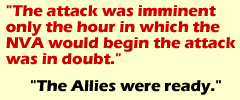 The next two days two other firebases were evacuated. "the important thing is," remarked Colonel Bowers, "the artillerymen on those three had already done their job of supporting the troops. There wasn't any need for them any longer on the hills. The operation on the ground were completed. And these firebases would have been evacuated soon anyway. They were sitting ducks." The next two days two other firebases were evacuated. "the important thing is," remarked Colonel Bowers, "the artillerymen on those three had already done their job of supporting the troops. There wasn't any need for them any longer on the hills. The operation on the ground were completed. And these firebases would have been evacuated soon anyway. They were sitting ducks."
While the evacuation of firebases occurred, the NVA redirected their shelling to the other allied bases located throughout the Duc Lap and Bu Prang areas. ARVN and American artillery batteries from the allied camps at Mike Smith and Bu Prang retaliated while the ARVN 45th and 53rd Regiments scouted the terrain for signs of the initially elusive enemy.
On November 2nd, a 19 vehicle convoy was ambushed on Highwy 14, seven klicks northwest of Firebase Dorie. At the same time, two light observation helicopters and one Cobra gunship were shot down near Firebase Helen. These actions precipitated a concentrated enemy effort to close the vital supply channels to the firebases that supported the allied ground offensive.
"If he had been successful in this," mentioned a top American advisor, "Charlie could have hurt us pretty bad. But as it was, we kept our supply slicks flying through on a regular basis. None of our firebases were hurting after the evacuation of the first three."
After the three choppers were shot down, the 22d ARVN Rangers initiated an intensive search for the pilots. The search, beginning shortly after the choppers were lost, lasted three days and saw the Rangers engage various-sized enemy units in contacts ranging from a few minutes to several hours. Their night positions came under fire, and during the day they warded off ambushes. The 1st Battalion, 53rd Infantry Regiment (23rd ARVN Infantry Division) linked with the Rangers and continued their search in a massive and systematic probe of the surrounding countryside. Contacts with the enemy continued in rapid succession for the remaining two days of the operation. More than 100 enemy dead were accounted for in the three-day operation.
While the main infantry effort during this three-day period centered on the recovery of the three chopper crews, the NVA artillery and infantry units began their attacks on the border outposts.
Ground probes of up to company size NVA units occurred almost nightly. Bu Prang, Dak Sak, Mike Smith, Duc Lap, as well as Firebases Helen, Dorie, and Ellen were kept under constant harassment with everything from mortars to the devastating 122mm rockets. The enemy intercepted resupply convoys, planted road mines, and anbushed security forces in an effort to isolate even furthere the small camps. With every supply chinook or slick, additional incoming rounds pounded the camp. "It got to the point," reported on Special Forces advisor at Bu Prang, "where we almost wished that the slicks wouldn't have to come in any more. Everty time they did come in, we knew that more rounds would be coming in within thirty seconds."
While the enemy pressured the allies, the 23rd ARVN Division proceeded to shift its forces. The first and second battalions of the 47th ARVN Regiment moved from their northern coastal area of operations into defensive positions encircling Ban Me Thout. This city, according to military strategists, would be the ultimate NVA goal. With the shuffling of the 47th Regiment's battalions, the entire 45th ARVN Regiment established its headquarters nearer the focal point of the conflict-Firebase Mike Smith, a few kilometers from Duc Lap District headquarters and Dak Sak CIDG camp.
But as the tempo of enemy shelling increased, it became obvious that the immediate objectives would be Bu Prang and Duc Lap. To counter this, the 47th ARVN Regiment once again deployed; this time from Ban Me Thuot to Nhon Co, the resupply station for Bu Prang and the CIDG camp itself. The 53rd ARVN Regiment remained in its headquarters location at Bu Prang, as did the 45th, with battalions scattered throughout Duc Lap District and at Mike Smith.
The second week of action saw an intensification of shelling, as it became apparent the ARVN infantry units were "holding their own" against the seasoned NVA regiment. The pattern for engagement with the enemy varied slightly. Based at strategic hilltops and camps within a few Klicks of their parent headquarters, the AVRN battalions conducted operations daily.Remaining in the field from one to three days, usually patrolling the areas surrounding the camps, the ARVN infantrymen encountered many NVA patrols.
"One of the battles was classic," recalled Lieutenant Colonel Leo Boucher, the 45th ARVN Regiment senior advisor. Utilizing APC's as the flanking element, a battalion of ARVN infantrymen conducted a sweep of an area adjacent to a resupply highway connecting Duc Lap sector headquarters with Firebase Helen. Screening the jungles and hills, they drove an NVA company toward the waiting APC's. After the battle, more than 40 enemy bodies were found.
The 2nd Mobile Strike Force Battalion, on a sweep within eyesight of Bu Prang, fought an unknown-sized enemy force from early dawn until sunset during the second week of the shelling. Reinforced by a battalion of the 53rd Regiment, they finally scattered the enemy by nightfall. Over 39 enemy soldiers died.
An NVA company began lobbing mortar and directing 75mm recoiless rifle fire into Bu Prang on November 10th. With the camp's defenders in their bunkers, the enemy unit staged a daring, daylight assault of the camp. When they were within 300 meters of the camp, an allied 105mm artillery section directed its tubes pointblank at the charging enemy. Within minutes only numerous blood trails leading back into the jungle told of the attackers' demise.
Although all the allied bases came under enemy fire during the 40 days of action, Bu Prang was perhaps the hardest hit. But almost as abruptly as it began, the action around Bu Prang ended. The initial reaction was caution. Would they concentrate on Duc Lap? Would they attempt to bypass these objectives in favor of Ban Me Thuot? Tension gave way to determination; determination to a feeling of victory, as it became apparent after two, three, then four days of quiet that the enemy had retreated. More than 1500 enemy soldiers had died. Countless blood trails indicated many more had been wounded. The ARVN soldier, aided by artillery and air support from Americans had proven his mettle. On his own terms he defeated the enemy. It was forcast.
|
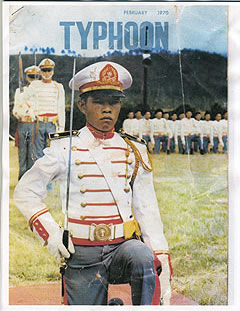
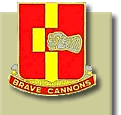

 The I Field Force Forward Movile Staff spearheaded the advisory effort throughout the month-long action. Analysis of the main-force enemy drive at Ben Het six months earlier indicated that a rapid communications and advisory rapport between the ARVN and I Field Force would be essential during the action around Bu Prang. The communication and advisory liinkup would insure effctive manipulation of forces required in massive defensive or offensive retaliation. Subsequently, I Field Force prepared to deploy representatives of each of its staff sections, in addition to various other personnel required to help counter a large-scale enemy buildup.
The I Field Force Forward Movile Staff spearheaded the advisory effort throughout the month-long action. Analysis of the main-force enemy drive at Ben Het six months earlier indicated that a rapid communications and advisory rapport between the ARVN and I Field Force would be essential during the action around Bu Prang. The communication and advisory liinkup would insure effctive manipulation of forces required in massive defensive or offensive retaliation. Subsequently, I Field Force prepared to deploy representatives of each of its staff sections, in addition to various other personnel required to help counter a large-scale enemy buildup.  The next two days two other firebases were evacuated. "the important thing is," remarked Colonel Bowers, "the artillerymen on those three had already done their job of supporting the troops. There wasn't any need for them any longer on the hills. The operation on the ground were completed. And these firebases would have been evacuated soon anyway. They were sitting ducks."
The next two days two other firebases were evacuated. "the important thing is," remarked Colonel Bowers, "the artillerymen on those three had already done their job of supporting the troops. There wasn't any need for them any longer on the hills. The operation on the ground were completed. And these firebases would have been evacuated soon anyway. They were sitting ducks." 